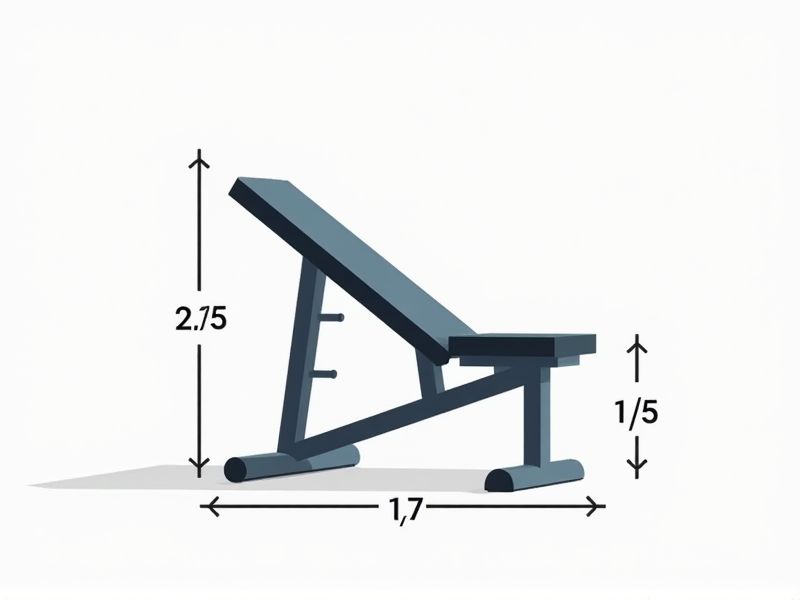
When selecting a bench press station, understanding standard dimensions can help ensure both safety and comfort during your workouts. Most bench press stations have a length of around 45 to 50 inches and a width of 20 to 26 inches, with the bench height typically falling between 16 and 18 inches from the ground. The distance between the barbell racks is generally about 42 to 48 inches, accommodating standard Olympic barbells. These measurements offer a reliable starting point, but always check the specific dimensions of your space and equipment before purchasing to ensure a proper fit for your exercise needs.
Width Of The Bench
The standard width of a bench used for bench pressing typically measures between 10 to 12 inches. This dimension is essential to provide adequate support for your shoulders and back during lifts. A wider bench, exceeding 12 inches, may hinder comfort and stability, affecting your overall performance. Ensuring your bench falls within this optimal width range helps you maintain proper form and reduces the risk of injury.
Length Of The Bench
The standard length of a bench press bench typically measures around 4 to 5 feet, allowing for adequate support while performing lifts. This length accommodates a variety of user heights, ensuring safety and comfort during workouts. A longer bench may provide additional stability for heavier lifts, while a shorter one can facilitate easier maneuverability in smaller gym spaces. Consider your workout environment and personal lifting needs when selecting a bench to optimize your fitness routine.
Height From Floor
The standard height for a bench press station typically ranges between 17 to 20 inches from the floor, ensuring optimal positioning for safety and effectiveness during lifting. This height allows lifters to maintain the correct angle for pressing while providing adequate support for their back. Adjusting the bench height can enhance your performance, accommodating various body types and lifting styles. A proper setup not only promotes proper form but also minimizes the risk of injury, making it crucial for strength training environments.
Pad Thickness
The standard bench press station emphasizes a pad thickness of 2 to 4 inches to enhance comfort and support during workouts. A thicker pad reduces the risk of injury by providing better cushioning, allowing you to push your limits safely. Most commercial gyms adhere to this standard, ensuring that the equipment is suitable for various body types and sizes. When selecting a bench for your home gym, consider models that prioritize this thickness for an optimal lifting experience.
Rack Width
The ideal rack width for a standard bench press station typically ranges from 44 to 48 inches. This measurement ensures optimal stability and accessibility, allowing users to maintain proper form during their lifts. A wider rack may enhance comfort for broader shoulders, while a narrower setup aids those with a more compact build. Always ensure the safety pins are securely positioned to prevent accidents during heavy lifts.
Rack Height
The optimal rack height for a standard bench press station is typically set between 36 to 48 inches, accommodating various athlete preferences and body types. This adjustable range ensures proper barbell access and safety during lifting, especially when performing heavy sets or training alone. For maximum effectiveness, align the barbell with your mid-chest level when lying on the bench, allowing for a full range of motion. Investing in a high-quality adjustable bench press station can enhance your training regimen and improve overall performance.
Distance Between Supports
The standard distance between supports for a bench press station typically measures 81 to 83 inches, which accommodates a variety of user heights and arm spans. This spacing ensures optimal stability while lifting and allows for efficient weight distribution across the bench. Proper placement of the supports contributes to a safe workout environment, minimizing the risk of injury during heavy lifts. For your home gym, measuring the dimensions of your space can help you select a bench press setup that meets these standards effectively.
Barbell Length Capacity
The standard bench press station requires a barbell length of approximately 7 feet (2.13 meters) to accommodate a range of lifters. Most Olympic barbells used in these settings have a weight capacity of 1,000 pounds (454 kg) or more, making them suitable for serious athletes. The distance between the barbell sleeves is typically 51 inches (1.3 meters) to allow for comfortable grip spacing. This design ensures that both novice and experienced lifters can perform effectively while minimizing the risk of injury.
Weight Capacity Limit
A standard bench press station typically features a weight capacity limit ranging from 300 to 1,200 pounds, depending on the materials and construction quality. Most commercial-grade benches are designed to support heavier weights, ensuring safety and stability during workouts. It's crucial to consider not just the weight limit but also the bench's dimensions and structural integrity to prevent accidents. When selecting equipment for your fitness regimen, prioritizing a bench with high weight capacity ensures you can progressively increase your strength without concern.
Bar Clearance Area
The bench press station demands a minimum bar clearance area of 36 inches (91 cm) horizontally on either side of the bench, ensuring safety and accessibility during lifts. The height of the bench typically stands at 17 to 20 inches (43 to 51 cm) from the ground, providing optimal positioning for various body types. It's essential to maintain a non-slip surface in this zone to prevent accidents, with a clear space of at least 24 inches (61 cm) behind the bench for spotting, which enhances safety during workouts. Proper spacing and clearance not only improve lifting performance but also contribute significantly to your overall gym experience.
